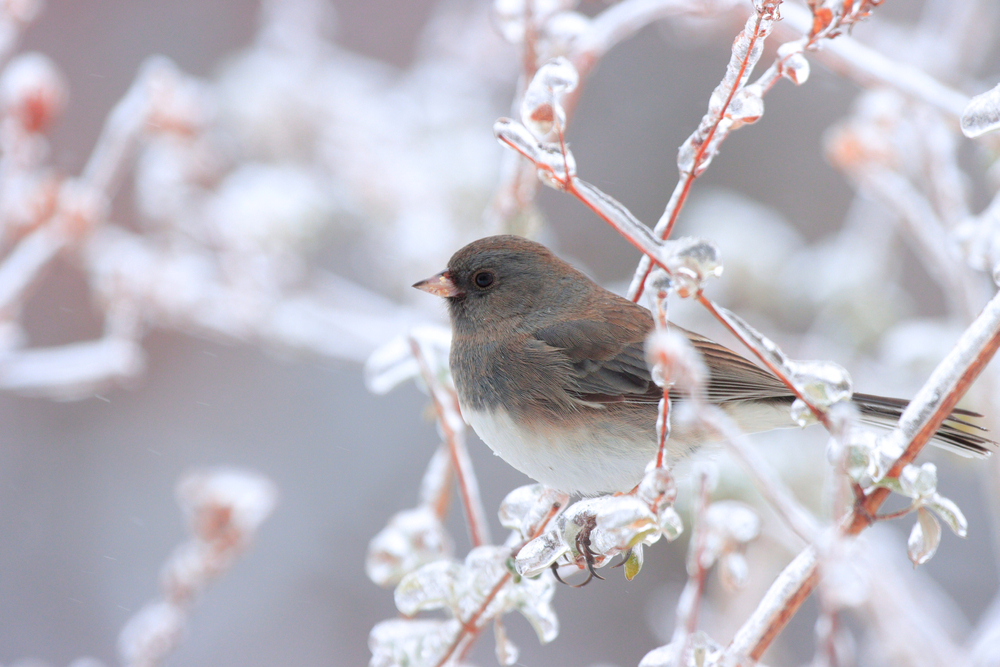There are only two separate species of junco in North America-the dark-eyed junco and the yellow-eyed junco. The dark-eyed junco has 15 subspecies grouped together by color type and location. Many of the subspecies look alike, but each bird has different physical features, habitats, and locations.
These small songbirds range from Mexico into Canada and Alaska. This common North American bird can be found in coniferous and mixed-coniferous forests, where they forage for seeds on the ground.
Juncos are a diverse group of songbirds. The junco is a passeriforme bird species in the New World sparrow family. We’ve gathered 9 of the most common junco birds along with some tips and tricks to tell them apart.
How do you identify the dark-eyed junco?
Dark-eyed juncos are small gray birds with tawny brown backs, wings, and crowns. They have white outer tail feathers and conical gray beaks. This coniferous forest-dwelling songbird is one of North America’s most common birds.
The dark-eyed junco (Junco hyemalis) is part of the New World sparrow family. They are somewhat small, with a wingspan of about 9 inches. As their name suggests, the dark-eyed junco has dark black eyes. Dark-eyed juncos come in a variety of subspecies, but all variables of the dark-eyed junco share the dark-colored eyes.
These spunky sparrows are ground foragers who spend nearly 5 hours a day hopping along the forest floor in search of seeds! You can also find this common bird species perching high in the trees. They are aggressive defenders of their territory, using their loud trill to ward off potential intruders.
The dark-eyed junco subspecies are divided into 6 color groups:
- Red-backed juncos
- Consists solely of the red-backed junco bird species. This color group is sometimes combined with the gray-headed group.
- Gray-headed juncos
- Made up of just the gray-headed dark-eyed junco.
- White-winged juncos
- Only the white-winged dark-eyed junco is in this group.
- Pink-sided juncos
- Containing the singular species, the pink-sided dark-eyed junco
- Slate-colored juncos
- This group consists of the slate-colored, Carolina, and Cassiar dark-eyed juncos.
- Oregon or brown-back juncos
- This is the largest color group. It consists of the Oregon, Montana, Nevada, Point Pinos, Laguna Hanson, Shufeldt’s, Thurber’s, and Townsend’s dark-eyed junco.
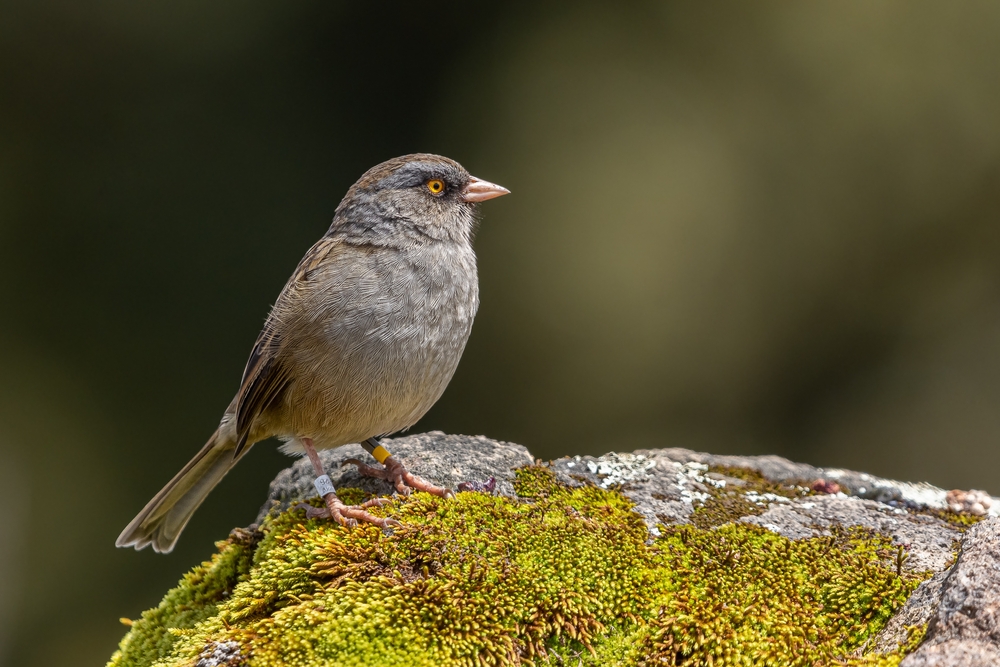
What are the key characteristics of the yellow-eyed juncos?
Yellow-eyed juncos have bright orangish-yellow eyes. Their fiery eyes are surrounded by a black ring, making them even more stunning in contrast to their gray feathers. Yellow-eyed juncos are the only junco birds that do not have dark eyes.
Yellow-eyed juncos(Junco phaeonotus) live year-round in Guatemala, Mexico, Arizona, and New Mexico. They have white outer tail feathers, two-toned beaks, and gray heads. Yellow-eyed juncos also have reddish-brown back markings that extend to their shoulders and over part of the wings. While these yellow-eyed beauties are easily picked out from other juncos, they share similar coloring to one subspecies of the dark-eyed junco.
The red-backed junco is the only subspecies in the red-backed color group but looks much like the yellow-eyed junco. During breeding season, these two bird species do not overlap at all. But, outside breeding season, the red-backed junco overlaps in a small part of the yellow-eyed junco’s range. Despite their similar appearance, the obvious bright fire color of the yellow-eyed junco’s eyes easily set these similar-looking bird species apart.
How do you identify the red-backed junco subspecies?
Red-backed juncos are a subspecies of the dark-eyed junco. Their dark eyes, white outer tail feathers, dark two-toned beaks, and slate gray heads help separate them from similar bird species. They have reddish-brown backs, light gray throats, and a black mask.
Red-backed juncos (Junco hyemalis dorsalis) are among the rarest of the dark-eyed junco subspecies. This non-migrant bird species lives in the mountainous regions in the southwestern United States. Their range is confined to the border of New Mexico, Mexico, and Arizona.
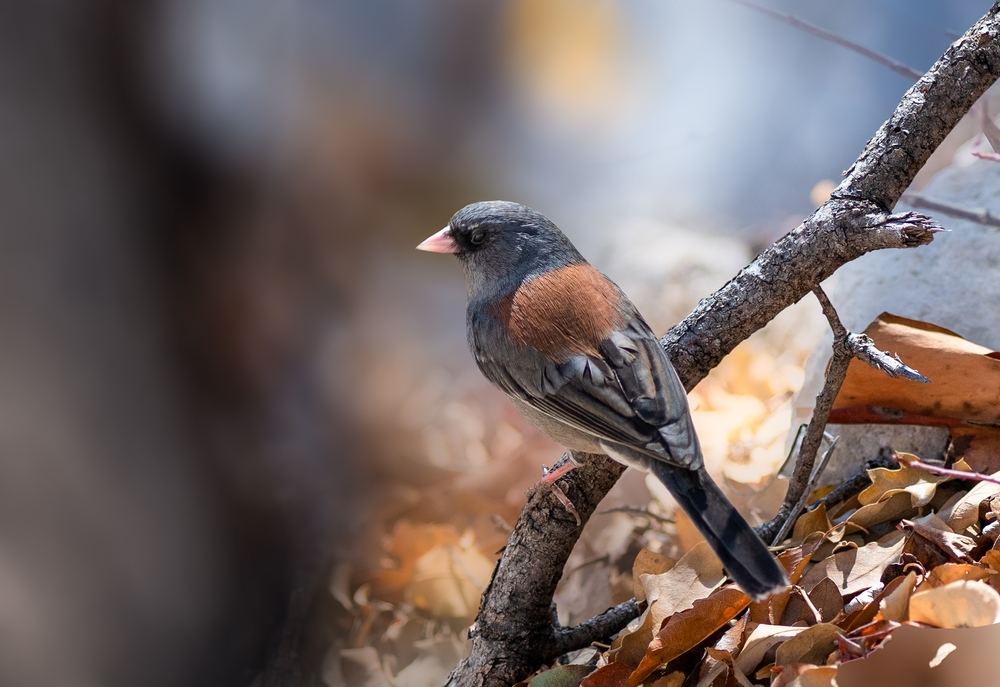
What do the birds of the Oregon junco subspecies look like?
Oregon juncos have coal gray heads and throats, with brown backs and wings. They have a soft gray belly with reddish-brown flanks. Bird species in this subgroup are also called brown-backed juncos.
The Oregon junco subspecies group is the most common in the western United States. They can be found throughout the Pacific Coast Mountain Range, from Alaska all the way to Mexico. Birds in this subspecies look nearly identical and are divided by location.
Oregon, Montana, Nevada, Point Pinos, and Laguna Hanson dark-eyed juncos are located in their namesake areas. The Shufeldt’s junco is found in New Mexico and is named after Robert Wilson Shufeldt II. The Thurber’s junco is found in and around Los Angeles and Alhambra, California. The Townsend’s junco can be found in the San Pedro region of California.
Which dark-eyed junco subspecies belong to the slate-colored junco group?
The slate-colored junco group consists of the slate-colored junco (Junco hyemalis hyemalis), the Carolina junco (Junco hyemalis carolinensis), and the Cassiar dark-eyed junco (Junco hyemalis cismontanus). Juncos in this subspecies group are slate gray all over with a pinkish-white beak. They have white bellies and white feathers on the underside of their tails. Females are generally duller and may have a brownish-gray or reddish-brown hue.
Slate-colored juncos are located in the Boreal Forest from Alaska to the Appalachian Mountains. They are common birds, with large populations happily living in this vast coniferous forest. During the winter, they can in fact be found in most of the United States, just like other dark-eyed junco bird species.
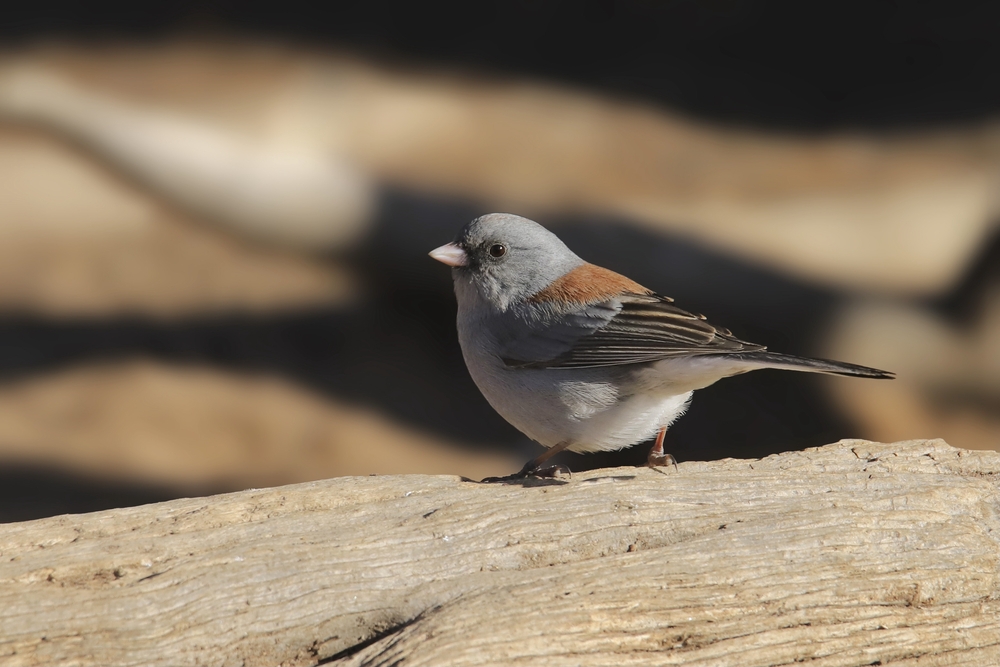
What does the white-winged dark-eyed junco look like?
The white-winged dark-eyed junco has silver gray upperparts and a white belly. The tail feathers are mostly white, with a small amount of silver feathering on the top in the center. White-winged juncos have white wing bars and silvery white beaks.
White-winged juncos (Junco hyemalis aikeni) are common in the Black Hills region of South Dakota, Wyoming, Nebraska, Colorado, New Mexico, and Montana. The contrast in silver and white coloring on males is striking, but females tend to be duller. White-winged junco females can have brownish-gray coloring. Instead of a bright white belly, female bellies are gray.
What does the pink-sided dark-eyed junco look like?
The pink-sided dark-eyed junco looks similar to the Oregon juncos. They have a pink bill, a medium gray head, and light reddish-brown wings. The pink-sided junco underparts are a soft cinnamon brown color, which has a pinkish hue. These pinkish markings on their sides are where they get their name.
Pink-sided juncos (Junco hyemalis mearnsi) spend the breeding season in the northern parts of the Rocky Mountains. They are a migrant bird species, flying as far south as Chihuahua, Mexico, for the winter. While this subspecies of dark-eyed junco is sometimes lumped in with the Oregon junco, pink-sided juncos are found farther inland and are overall lighter colored.
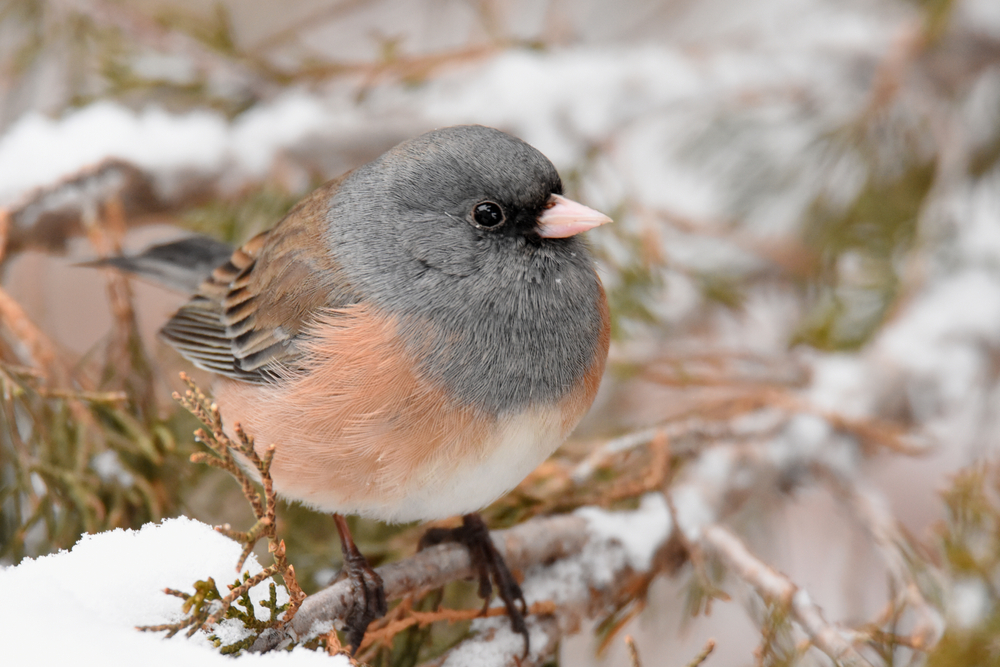
How do you identify the gray-headed junco?
The gray-headed junco subspecies is a bluish-gray overall with a darker gray head, white outer tail feathers, and a brown back. They look very similar to the red-backed junco subspecies, but the gray-headed junco’s beak is light gray and has a single tone. Both the gray-headed and the red-backed junco were once a single subspecies group called the brown-back junco.
Gray-headed juncos (Junco hyemalis caniceps) spend breeding season in Northern Nevada, Colorado, and Utah. Gray-headed juncos head south and east during the winter, seeking out warmer weather. They stay relatively close to the breeding range but can spread as far as southern Mexico and west Texas.
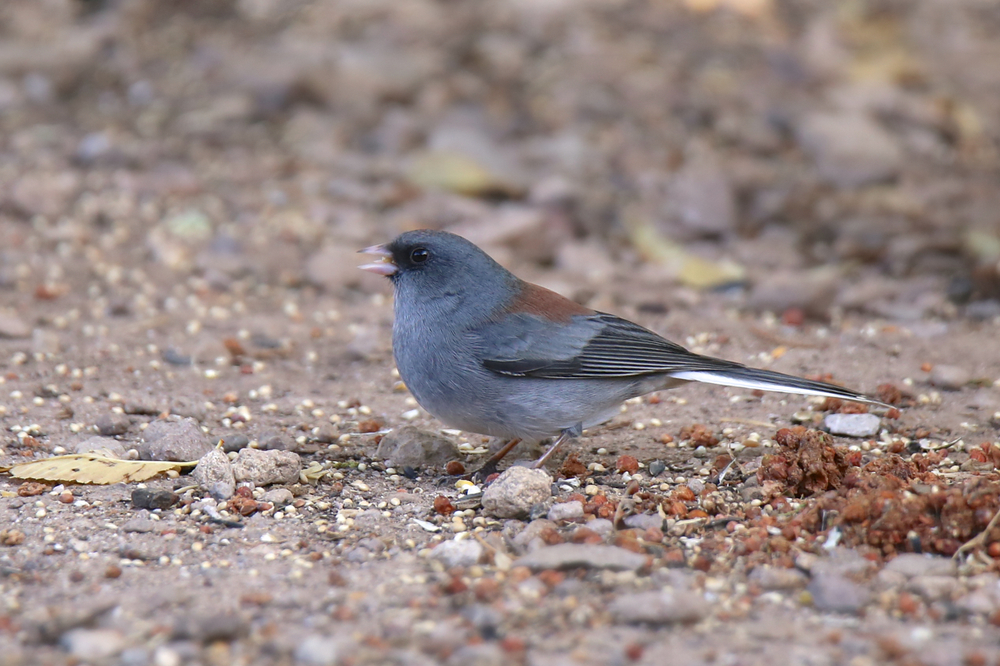
Is the Guadalupe junco a subspecies of the dark-eyed junco?
The rare Guadalupe junco used to be classified as a subspecies of the dark-eyed junco. As of 2016, the endangered Guadalupe Island junco bird (Junco insularis) is a separate species from the dark-eyed junco. As with many reclassifications, the ornithological community isn’t entirely in agreement over this change.
The Guadalupe junco has dark eyes, a gray head and body, and a black eye line. Reddish-brown sides line its white belly. This unique little bird is one of several bird species threatened by invasive mammals. Steps are being taken to eradicate invasive animals like cats and rodents, but the Guadalupe junco is already severally endangered.
When is the junco’s breeding season?
The dark-eyed juncos breed from March until May. The yellow-eyed junco’s breeding season begins in April. Junco bird species are monogamous for the duration of breeding season, but they have been known to choose new mates every year.
Junco pairs have 1-2 brood per year, but having 3 broods in a single breeding season is not unheard of. The female junco builds the cup-shaped nest on or near the ground, hidden in tall grasses, brush, or dense undergrowth. While the male doesn’t help build the nest, he will bring her materials like grasses, pine needles, and leaves.
Female juncos can lay up to 6 pale blue eggs with brown speckles, but 3-4 eggs per brood is the average. Eggs hatch in about 12 days. Young juncos leave the nest about 2 weeks after hatching. Juncos sometimes reuse their nests, but typically they build a new nest for each brood, which helps control parasites.
Quick facts about juncos:
- The trill of the dark-eyed junco sounds a lot like both the chipping sparrow and the pine warbler.
- All 3 species are found in similar areas, which makes identifying them by their call alone very challenging.
- Dark-eyed juncos are migrant birds, while yellow-eyed juncos stay in the same place year-round.
- Dark-eyed juncos are considered snowbirds because they head south as soon as snow appears.
- Since this migrant bird flies south so early in the season, folk tales often credited juncos and other snowbirds with bringing winter on their wings.
- Dark-eyed juncos spend breeding season in Canada and Alaska, with only a few birds sticking around those areas for the colder months.
- Juncos love bird seed and millet.
- While they will use platform bird feeders, you’re more likely to find them picking up bird seed from the very ground beneath your bird feeders.
- While juncos prefer dense vegetation and coniferous forests, these abundant songbirds can be found around parks and along roadsides during the winter.
Junco birds are such a diverse and colorful family of songbirds; it’s no wonder they’re a favorite of birders in North America. Whether you find them while hiking through a dense forest or hanging out in your own backyard, these New World sparrows are quite enjoyable to watch as they hop around in search of seeds. Using these identifying features and exciting facts about juncos, you’ll be able to tell these 9 types apart like a pro!

